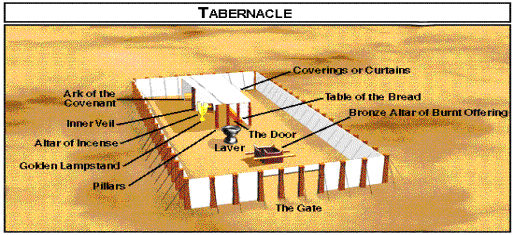Old Testament Survey
Exodus, Part 2
The Tabernacle
God’s desire is to dwell with mankind in the same manner He walked with Adam in the Garden of Eden. Today Christians are indwelt by the Holy Spirit, so God walks with us, but not in the close fashion found in the Garden. In the millennium Christ will rule on earth, and, then, in eternity, we are all with God in a closeness which will surpass that of Adam and Eve. The beginning of this dwelling was seen at Passover as the pillar of cloud and the pillar of fire led the Israelites out of Egypt (Exod 19:9, 18; 24:17). While this pillar was not as prominent after the disobedience of the people, it was still the desire of God to dwell amongst His people.
The plan for the Tabernacle is given to Moses in great detail (Chps 25-31). While the episode with the golden calf interrupts the building of the Tabernacle, Exodus records the construction of the Tabernacle which becomes the home of God’s presence among His people (Chps 35-40). His glory fills the Holy of Holies as He sits on the mercy seat to commune with the people through Moses.
The Tabernacle is described as a pattern of the heavenly throne (Heb 9:23). More room is given to the description of the Tabernacle than to any other single subject. Scripture clearly teaches the Tabernacle is a portrayal of Christ (Heb 9:8-12). In this sense the Tabernacle is a “type” of Christ.

God’s direction to the people covered more than just the mere formalities of the law or the rich structure of the rituals for the Tabernacle. God should that Israel way His people and He was there King in every facet of daily life, including, leading them with the pillar of cloud and fire, as well as giving them precise directions on how to march and the order for establishing a camp.

Marching Oder of the Tribes
Direction of March -> The Ark of the Covenant goes in front
| Dan Asher Naphtali |
Ephraim Manasseh Benjamin |
Tabernacle
Furniture (Levi - Kohath) |
Reuben Simeon Gad |
Tabernacle
Material (Levi - Gershon, Merari) |
Judah Issachar Zebulun |
ARK |
Keep in mind that the Tabernacle is not just a picture of the coming Messiah. The Tabernacle was extremely important to the Israelites of the Exodus. It was the dwelling place of God and while it and its furnishings point toward Christ, they have significance of their own right during the Exodus and beyond.
- The Ark of the Covenant symbolizes God’s actual presence with the Jewish nation
- The Shewbread reminds the Israelites that God provides their daily necessities
- The Lampstand is a picture of God lighting the way
- The Altar of Incense represents prayer and God’s eternal presence with the people
- The Bronze Laver or Basin shows the need for purity before meeting God
- The Burnt Offering Altar addressed the need for forgiveness
Jesus in Exodus
The Tabernacle is the biggest picture of Jesus in this book. A fuller explanation of this type of Christ is found in the next, short chapter. But, there are other pictures of Jesus in Exodus.
Moses is the prophet who anticipates Christ(Deut 18:15). He is the kinsman-redeemer who saves the nation of Israel from the bondage of Egypt. Moses is also the leader of the nation, although he is not called a king.
The Passover lamb causes us to look forward to Jesus, the Lamb of God (John 1:29, 36; 1 Cor 5:7).
The seven feasts outlined in this book all point to the work of Christ. We will look at these in more detail in the chapter on Leviticus.
Manna from heaven and the water from the rock also point to Jesus, the bread of life (John 6:31-35, 48-63; 1 Cor 10:3, 4).
The work of the priests all look forward to Jesus our High Priest (Heb 4:14-16; 9:11, 2, 24-28).
And finally, the Exodus itself is a picture of our identification with Jesus as a baptism (Rom 6:2, 3; 1 Cor 10:1, 2).
What is your “golden calf?”
Footnotes:
2. J. Hampton Keathley III, Concise Old Testament Survey, Biblical Studies Press, L.L.C,
www.bible.org, 1997, 6.
3. Keathley, 10.
